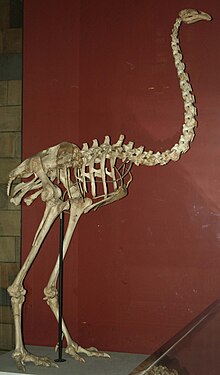North Island giant moa
| North Island giant moa Temporal range: Late Pleistocene- Holocene
| |
|---|---|

| |
| Skeleton, Natural History Museum of London | |
| Scientific classification | |
| Domain: | Eukaryota |
| Kingdom: | Animalia |
| Phylum: | Chordata |
| Class: | Aves |
| Infraclass: | Palaeognathae |
| Order: | †Dinornithiformes |
| Family: | †Dinornithidae |
| Genus: | †Dinornis |
| Species: | †D. novaezealandiae
|
| Binomial name | |
| Dinornis novaezealandiae | |
| Synonyms | |
|
List
| |
| Measurements | |||
|---|---|---|---|
| North Island [3] | |||
| Length | 240 cm (94 in) | ||
| 300 cm (120 in) | |||
| Weight | 55–88 kg (121.3–194.0 lb) | ||
| 78–249 kg (172.0–549.0 lb) | |||
The North Island giant moa (Dinornis novaezealandiae) was a type of moa. It only lived in New Zealand. It could not fly.[4]
References[change | change source]
- ↑ Brands, S. (2008)
- ↑ Checklist Committee Ornithological Society of New Zealand (2010). "Checklist-of-Birds of New Zealand, Norfolk and Macquarie Islands and the Ross Dependency Antarctica" (PDF). Te Papa Press. Retrieved 4 January 2016.
- ↑ Birds of New Zealand
- ↑ Grzimek, Bernhard (2003–2004). Grzimek's animal life encyclopedia. Neil Schlager, Donna Olendorf, American Zoo and Aquarium Association (2nd ed.). Detroit: Gale. ISBN 0-7876-5362-4. OCLC 49260053.
